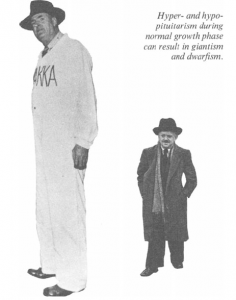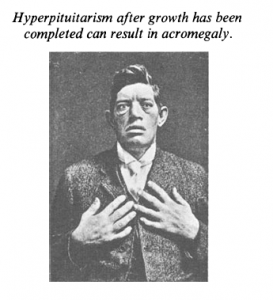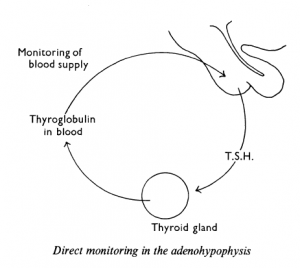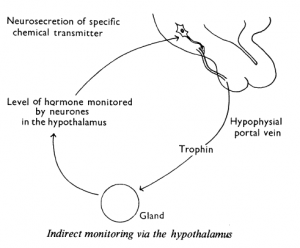The adenohypophysis secretes six main hormones. They are all proteins; two of them, Growth Hormone and Prolactin, act directly on target organs whereas the others act as ‘trophins’, that is, they promote the activity of other endocrine glands.
Growth hormone ( G.H.)
This is a protein of mol. wt. approximately 49,000. In its action, it parallels the anabolic steroids with regard to protein metabolism in tissues. It also parallels the action of thyroxin. Overactivity of the adenohypophysis can produce growth abnormalities. In man, overactivity at a pre-pubertal stage can give rise to gigantism; increased height, frequently 7 to 8 feet, accompanied by hypertrophy of internal organs and skeletal muscles. Post pubertal hyperactivity leads to the growth of bones in the hands and feet, the facial bones, and the jaw, a condition which is termed acromegaly in man.

Prolactin (lactogenic hormone)
This hormone is present in the pituitaries of all vertebrates examined and in approximately equal quantities in the male and female. It promotes the secretion of milk from the mammary glands in the mammal providing they have been activated previously by ovarian hormones.
Thyrotrophic hormone (T.S .H.)
The thyrotrophic hormone promotes the secretion of thyroglobulin from the thyroid gland, thus is an indirect regulator of metabolic rates in all vertebrates and of metamorphosis in amphibia. It helps in the production and the release of T3 and T4
Adrenocorticotrophic hormone ( A.C.T.H.)
Hypophysectomy, which is the removal of the pituitary gland in experimental animals, leads to atrophy of the adrenal cortex. Injections of ACTH into experimental animals promote adrenocortical activity such as the secretion of 17-oxosteroids.
Gonadotrophins
These are proteins of mol. wt. approximately 65,000. Interstitial cell-stimulating hormone (I.C.S.H.), which promotes spermatogenesis in the male mammal, and Follicle Stimulating Hormone (F.S.H.), which promotes the maturation of ova in the ovaries, are probably the same gametogenic hormone. A second gonadotrophic hormone, Luteinising Hormone (L.H.) acts in the female in conjunction with F.S.H. to induce ovulation and thereafter promotes the development and hormonal activity of the corpus luteum.

Control of anterior pituitary function
This topic, which is central to the whole concept of an integrated pattern of hormonal coordination and response, is the subject of some speculation. The activity of the adenohypophysis may be subject to two control modes:
- By direct monitoring feedback, through the carotid artery and the anterior pituitary artery. Thus the output of, say, T.S.H. by the cells of the adenohypophysis depends inversely upon the concentration of thyroglobulin in the blood supply to the gland.

- By indirect monitoring feedback, involving the hypothalamus, which is that region of the brain immediately above the pituitary gland and corresponding to the floor of the 3rd ventricle. There is evidence that neurons in the hypothalamus monitor the levels of hormones in the blood and these cells then secrete a ‘chemical transmitter’. This substance, which is unlikely to be one of the usual neurosecretory substances, such as acetylcholine, then passes to the anterior lobe, either by diffusion down the infundibular stalk, or, more likely, by the bloodstream in the hypophysial portal system. This portal system consists of a number of veins arising from a capillary bed in the hypothalamus and ending in capillaries in the anterior lobe. A hypothesis involving the brain in endocrine regulation is attractive since it can accommodate permutations involving environmental factors which are perceived through sense organs, for example, the effect of daylight length on the initiation of reproduction in some birds and mammals.

